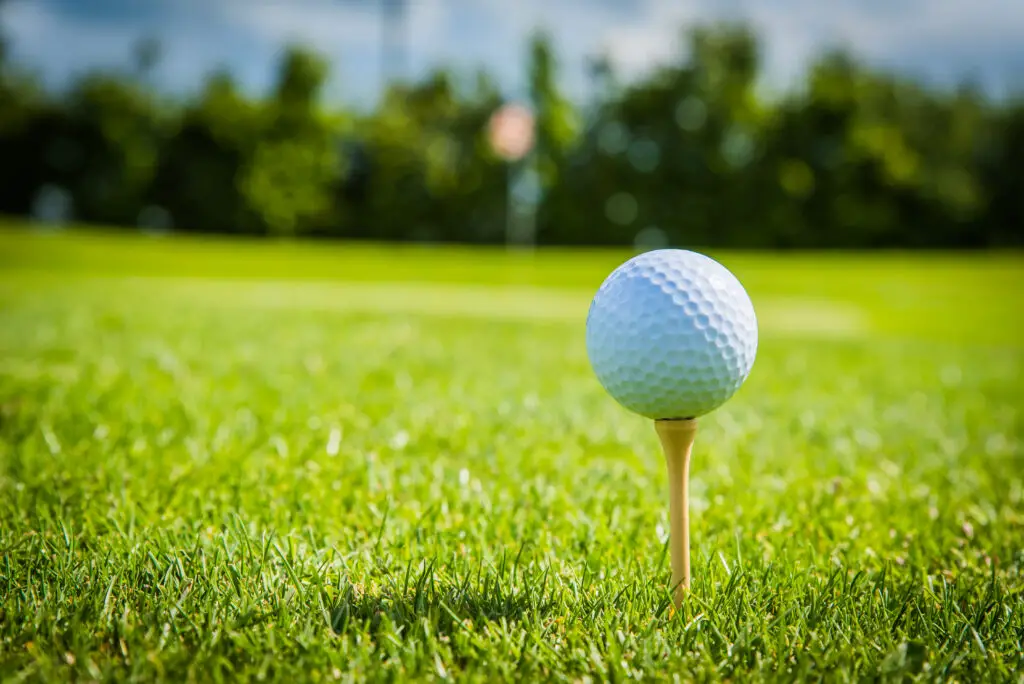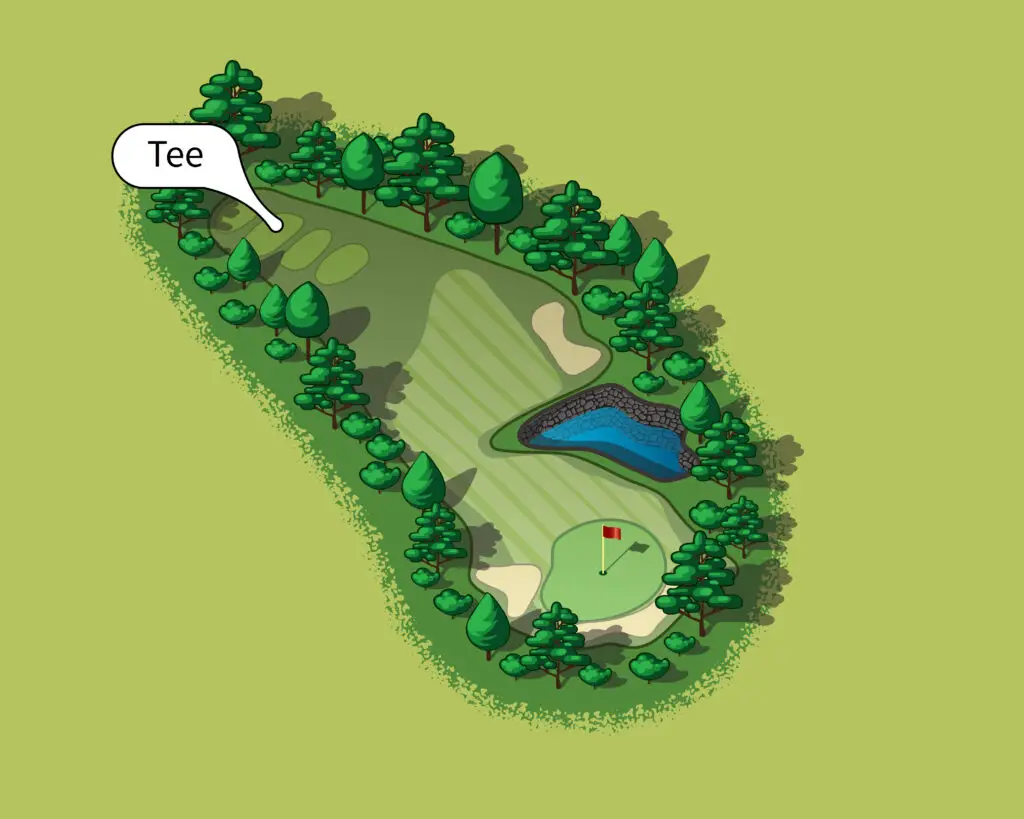Tee
What is the definition of A Golf Tee in Golf?
The game of golf incorporates various tools and techniques, one of which is the seemingly humble yet essential piece of equipment known as the golf tee. A golf tee is a small, wooden or plastic peg that is used to support a golf ball, enabling the golfer to strike it more efficiently with lower lofted golf clubs. By teeing the ball up, it provides a stable and consistent platform for the golfer to place the ball at the desired height, making it easier for them to hit the ball with precision and power.
Golf tees come in different sizes and materials, but according to the United States Golf Association (USGA) equipment rules, the maximum length of a tee is 4 inches. While tees’ primary purpose remains to raise the ball off the ground, there are various designs available to cater to individual preferences and playing styles. Some golfers might prefer a certain length or type of tee based on their skill level, club selection, or personal preference.
Over time, the rules and regulations regarding the use of tees in golf have evolved, keeping players’ needs and game improvements in mind. As a golfer, it’s essential to understand the role of tees, their variety, and their significance in enhancing the overall experience on the golf course.
Key Takeaways
- Golf tees are essential tools that provide a stable and consistent platform for golfers to place the ball at the desired height.
- Tees come in different sizes and materials, catering to the preferences of individual players.
- Knowledge of tees, their use, and the rules surrounding them can enhance a golfer’s overall experience on the course.
Basic Understanding of Golf Tee
A golf tee is a small, essential accessory used in the sport of golf. It is typically a thin peg made of wood or plastic, measuring about two to three inches in height. When playing a golf shot, the tee is pushed down into the turf on the teeing ground, and the golf ball is placed atop the golf tee in a stable and stationary position.
The primary purpose of a golf tee is to provide a consistent platform for the golfer to place the ball at the desired height, allowing for more efficient shots with lower lofted golf clubs. This elevation and support are particularly beneficial during the first golf shot or stroke of every hole, which is made from the tee box area.
When setting up at the teeing ground, players must pay attention to the tee markers. Tee markers are usually colored rocks or other elements that mark the boundaries of the tee box section. Different colors represent different distances to the hole and levels of difficulty. Players are required to tee the ball up behind the line created by the tee markers. The ball can be teed up anywhere between the two markers, and as far back as the length of two drivers: if a driver is 45 inches long, for example, the teeing area extends up to 90 inches behind the imaginary line. It is important to remember never to place the tee in front of the tee markers, as this would violate golf rules.
In summary, a golf tee is an essential tool that helps golfers elevate and support the golf ball for their initial shot on each hole. The tee, along with the designated tee box area, ensures consistent and efficient shots, making it a critical component of any golfer’s equipment.

Purpose and Use of Golf Tee
A golf tee is a small tool designed to raise the ball off the ground, which aids golfers in achieving more consistent results when striking the ball. By elevating the ball, golfers can hit it with less resistance, improving the overall performance and accuracy of their shots.
Golf tees are typically used for the first shot on each hole, known as teeing off. This is done from the designated tee box area of the course. Once the golf ball is positioned on the tee, golfers take their swing and aim for the target, usually the green or the hole itself.
According to the United States Golf Association (USGA) equipment rules, a tee must not:
- Be longer than 4 inches (101.6 mm)
- Be designed or manufactured in a way that indicates the line of play
- Unduly influence the movement of the ball
- Assist the player in making a stroke or in their play
It is important for golfers to adhere to these rules to ensure fair play and compliance with golfing regulations. While golf tees may seem like a small detail of the game, they play an essential role in helping golfers achieve better and more accurate results on the course.
In conclusion, the purpose of a golf tee is to raise the ball slightly off the ground, making it easier for golfers to hit and allowing for more consistent outcomes. Tees are a vital component of golf and contribute to improved player performance when used correctly.
Variety in Golf Tees
Material Differences
Golf tees can be made from a variety of materials, each with its own unique characteristics and benefits. The most common materials used for tees include:
- Wooden tees: These are the traditional choice, typically made from hardwoods like maple or birch. They are budget-friendly and widely available, but they can break more easily than other materials.
- Bamboo tees: As eco-friendly options gain popularity, bamboo tees have emerged as an environmentally friendly alternative to wooden tees. They are sturdy, durable, and biodegradable, but can be slightly more expensive than wooden tees.
- Plastic tees: Known for their durability and flexibility, plastic tees are less likely to break during a round of golf. They also tend to maintain their shape better than wooden tees, providing a more consistent performance.
Size Differences
Golf tees come in various sizes to accommodate different preferences and requirements. The height of a tee can greatly influence the golfer’s swing and shot trajectory. The most common golf tee sizes are:
- Short tees (1-1.5 inches): Ideal for low-profile clubheads like fairway woods, hybrids, and irons, short tees provide a low, stable base for these clubs.
- Standard tees (2-2.5 inches): Suitable for most drivers, standard tees are designed to provide optimal launch conditions and accommodate a wide range of player preferences.
- Long tees (3-4 inches): Favored by professional golfers and players who prefer to set up their shots higher, long tees can deliver a lower spin rate and greater distance but require a more precise swing to achieve optimal results.
Each golfer may have their own preference for tee height and material based on their skill level, club selection, and course conditions. Experimenting with a variety of tees and practicing with different styles can help players find the right combination for their individual needs and swing preferences.

Rules and Regulations Regarding Tees in Golf
Golf tees are small devices used to raise the ball off the ground for the first stroke on each hole. They come in various shapes and sizes and are typically made from plastic or wood. While tees play a crucial role in starting each hole, there are specific rules and regulations set by the USGA (United States Golf Association) that golfers must adhere to when using tees.
According to Rule 6.2 of the USGA Equipment Rules, a tee must not:
- Be longer than 4 inches (101.6 mm);
- Be designed or manufactured in such a way to indicate the line of play;
- Unduly influence the movement of the ball;
- Or otherwise assist the player in making a stroke or in his play.
These regulations ensure that tees provide a fair starting point for each golfer and do not give them a competitive advantage. Golfers must pay close attention to these guidelines when choosing their tees to avoid violating the rules and receiving penalties.
The teeing area is another essential aspect in golf, defined as one of the five areas of the course. Players must place their tees within this designated area to start each hole. Placing the tee outside the teeing area can lead to penalties and impact the golfer’s overall score.
In conclusion, using tees in golf is regulated by the USGA’s rules, which dictate their dimensions, design, and placement in the teeing area. Adhering to these regulations ensures a fair and competitive game for all players involved.
Historical Development of Golf Tees
The golf tee has undergone several changes in its history, from simple mounds of sand to the common wooden and plastic pegs we see today. In the early days of golf, players would fashion raised mounds of sand provided by the course to elevate the ball for their opening shot on each hole. This practice lent its name to the current term “teeing ground.”
In the late 19th century, many golfers began experimenting with various methods to lift the ball off the ground more conveniently. The first patent application for a golf tee was submitted by two Scottish gentlemen, William Bloxsom and Arthur Douglas. Their invention, however, bore little resemblance to the modern golf tee.
A significant figure in the development of the golf tee was Dr. George Grant, the first black graduate of Harvard’s dental school. His design, patented in 1899, consisted of a vertical rubber tube attached at its base to a carrot-shaped piece of wood. Though it was an advancement from using hand-molded sand tees, Grant’s invention did not become widely popular.
As time went on and the popularity of golf continued to grow, various inventors began to improve upon the concept of the golf tee. This led to the development of the familiar peg-shaped tee that dominates the sport today. With these more convenient and practical tees, the game of golf has become more accessible and enjoyable for players at all levels.
Impact on Golf Game
Effect on Distance
A golf tee has a significant impact on the distance a golfer can achieve with their shots. By elevating the golf ball off the ground, the tee reduces resistance and friction between the ball and the ground. This allows for a cleaner, more efficient strike, leading to increased distance, especially on the opening shot of each hole. Golfers can select tees of various heights to tailor their shots according to their preferences and abilities, allowing for optimal distance and performance.
Influence on Accuracy
In addition to affecting the distance, a golf tee also plays a crucial role in the accuracy of a golfer’s shots. By providing a stable and consistent support structure, the tee allows the golfer to make square contact with the ball. This square contact ensures that the clubface directly hits the ball, resulting in a straight and accurate shot. Golfers can experiment with different tee heights to find the best support for their clubface at impact, further enhancing their accuracy and control during tee shots.
